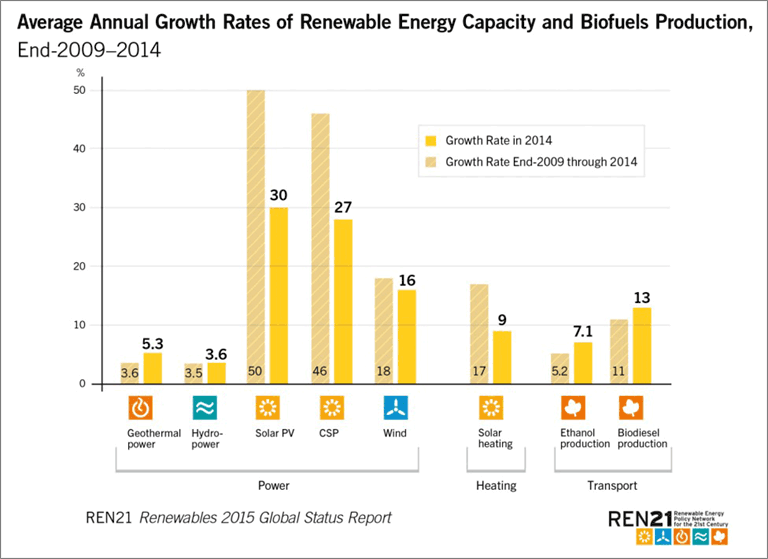Several years ago, when I was working on my book Power Plays, I spent a lot of time thinking about the future of energy. One thing I concluded was that solar power would become one of the world’s most important sources of energy – if not eventually the most important source of energy. I also discussed this in the 2007 column “The Future Is Solar.”
There are a couple of reasons I still believe this. But first, I should make it clear that it will be a long time before solar power rivals the consumption of oil in the global energy market.
While solar power is growing rapidly, we still use about 100 times as much energy in the form of oil (and about 90 times as much in the form of coal). Further, even though solar power is growing at a fast rate, the absolute growth in oil consumption from 2013 to 2014 was about 3 times the growth in solar power consumption. In other words, even though solar consumption grew at a 38% rate and oil consumption grew at about a 0.7% rate, this amounted to an increase in solar consumption of 11.6 million metric tons of oil equivalent versus an increase in oil consumption of 32 million metric tons.
Check out Money Is Energy: George Mobus Discusses Biophysical Economics and Alternative Theories of Value
So I want to at least offer that perspective, which is often missing in articles about renewable energy sources. Still, what I would say today is that solar is the most important emerging energy source, and over the next one to two decades it will surpass coal and begin to rival oil in the amount of energy supplied globally.
I believe the key drivers behind solar’s continued growth are that the energy conversion efficiency is relatively high (~an order of magnitude greater than photosynthesis) and that the costs for solar PV have become competitive in many markets. Further, those costs continue to fall. Solar is a very attractive option for those seeking to reduce carbon dioxide emissions.
Among all major energy sources, none added capacity as rapidly as the 50% average annual growth rate of solar photovoltaics (PV) over the past five years.
Growth in solar PV over the past decade has resulted in a nearly 50-fold expansion in the amount of deployed solar PV capacity since 2004:
Of course, capacity isn’t the same as production. As I pointed out in Don’t Blame Renewable Energy For Dying U.S. Coal Industry, the capacity factors for renewables like wind and solar power are low relative to their fossil fuel competitors. So an installed megawatt (MW) of solar PV capacity won’t produce the same amount of electricity over the course of a year as an installed MW of coal-fired power (for instance). In fact, it could take more than three times the installed capacity of solar to generate the amount of electricity from a given capacity of coal-fired power in a year.
This means that if solar is to make a serious dent in the world’s fossil fuel demand, we are going to be installing a lot of solar panels. Who makes these solar panels?
You may also like Natural Gas Bankrupted the US Coal Industry
According to research and consulting firm GlobalData, the Top 5 solar PV manufacturers in 2015 were China’s Trina Solar with 4.55 Gigawatts (GW) of solar PV panels produced, followed by Canadian Solar (3.9 GW), Chinese companies JinkoSolar Holding Co., Ltd. (3.79 GW) and JA Solar Holdings Co., Ltd. (3.38 GW), with South Korea’s Hanwha Q CELLS Co., Ltd. (3.2 GW) round out the Top 5. While China dominates in global PV manufacturing, two U.S. producers in the Top 10 are First Solar and SunPower.
If solar PV growth continues as I expect, the sector should do quite well overall, but SunEdison’s recent bankruptcy show that bad decisions can quickly take down large companies in rapidly growing sectors. It’s important to keep that in mind and do your due diligence before diving into this sector.
Link to Original Article: The Solar Story Is Just Getting Started








